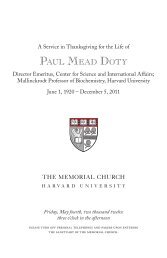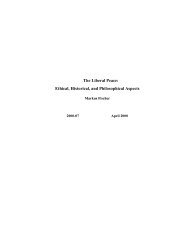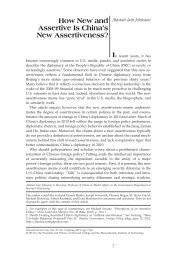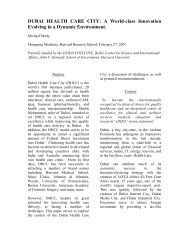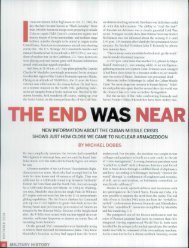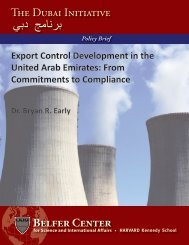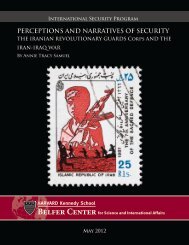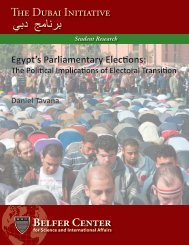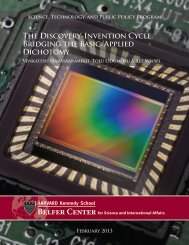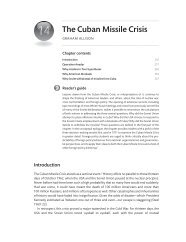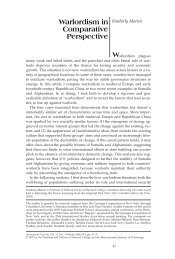The Cuban missile crisis and intelligence performance
The Cuban missile crisis and intelligence performance
The Cuban missile crisis and intelligence performance
Create successful ePaper yourself
Turn your PDF publications into a flip-book with our unique Google optimized e-Paper software.
Downloaded by [Harvard College] at 08:23 18 September 2012<br />
180 INTELLIGENCE AND THE CUBAN MISSILE CRISIS<br />
essay we will tackle the larger, more cosmic questions, such as why the<br />
three countries so badly misunderstood each other - questions which are the<br />
primary focus of the essays by Wirtz <strong>and</strong> Fischer.<br />
US Puzzles<br />
As we explain in our introductory essay, we believe the two most commonly<br />
asked 'why' questions about American <strong>intelligence</strong> in the <strong>Cuban</strong> <strong>missile</strong><br />
<strong>crisis</strong> - (1) Why did DCI McCone, but not his analysts, anticipate a Soviet<br />
deployment?; <strong>and</strong> (2) Why did American <strong>intelligence</strong> discover the <strong>missile</strong>s<br />
only in mid-October? - are both relatively unimportant <strong>and</strong> fairly easy to<br />
answer when understood - as most historians of the <strong>crisis</strong> have understood<br />
them - as questions of historical detail. McCone got lucky (an insight<br />
devoid of practical implications for <strong>intelligence</strong>); the weather in Cuba was<br />
bad (ditto). We do not propose to consider them further here. <strong>The</strong>y do,<br />
however, raise larger 'why' questions which we propose to examine in some<br />
detail later: namely, (1) Why did US <strong>intelligence</strong>, in attempting to estimate<br />
the likelihood of a Soviet nuclear deployment in Cuba, use as the basis of<br />
their judgment one set of assumptions about Soviet behavior rather than<br />
some other available set that might have led to a radically different<br />
estimate?; <strong>and</strong> (2) Why did American <strong>intelligence</strong> employ such an exacting<br />
st<strong>and</strong>ard of proof — direct photographic evidence of nuclear <strong>missile</strong>s —<br />
before being willing to conclude that a deployment of the kind President<br />
Kennedy had specifically warned the Soviet Union against, both publicly<br />
<strong>and</strong> privately, was, in fact, underway?<br />
To help answer these larger 'why' questions, it would be helpful to know<br />
the answers to two related nitty-gritty questions. First, why did US analysts<br />
ignore the estimate of the size of the Soviet force in Cuba provided by the<br />
operational branch of the CIA? Samuel Halpern has testified that Task Force<br />
W concluded in September 1962 that there were 45,000-50,000 Soviet<br />
military personnel in Cuba. <strong>The</strong> official American estimate in early October<br />
was 4,000-4,500 - an order of magnitude lower. 26 As we now know, the<br />
operations people had it just about right. Halpern is certain that CIA<br />
analysts received the Task Force W estimate in September, but does not<br />
know what happened to it. Why did the estimators dismiss it?<br />
<strong>The</strong> only defensible reason would be that they had some contrary<br />
evidence to suggest that the estimate must have been off by about an order<br />
of magnitude. If so, this evidence has never been made public. <strong>The</strong>re are at<br />
least three other possible (non-mutually-exclusive) explanations - one<br />
bureaucratic, one cognitive, <strong>and</strong> one motivated:<br />
• <strong>The</strong> estimators may simply have been defending their turf. Estimates,<br />
after all, were their job.



